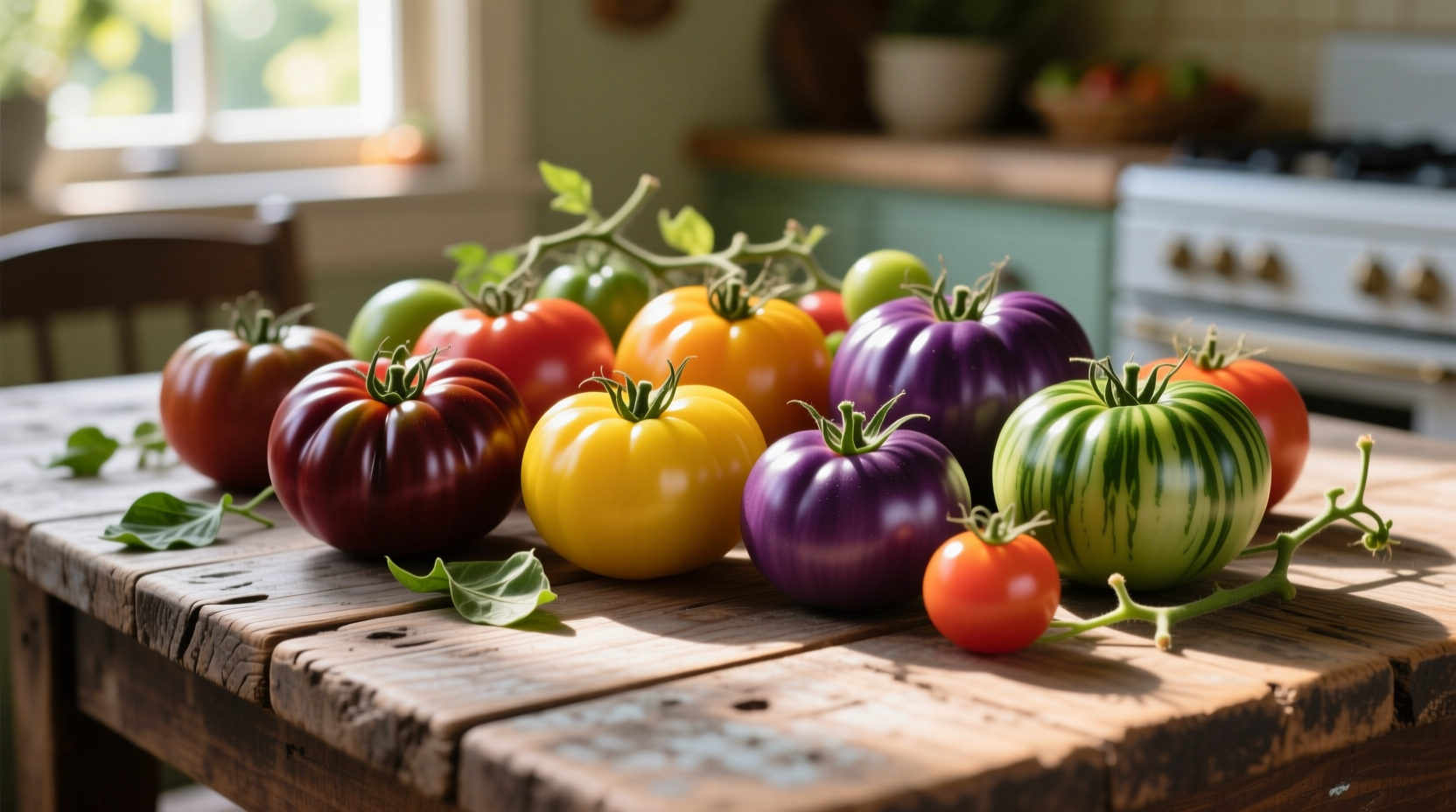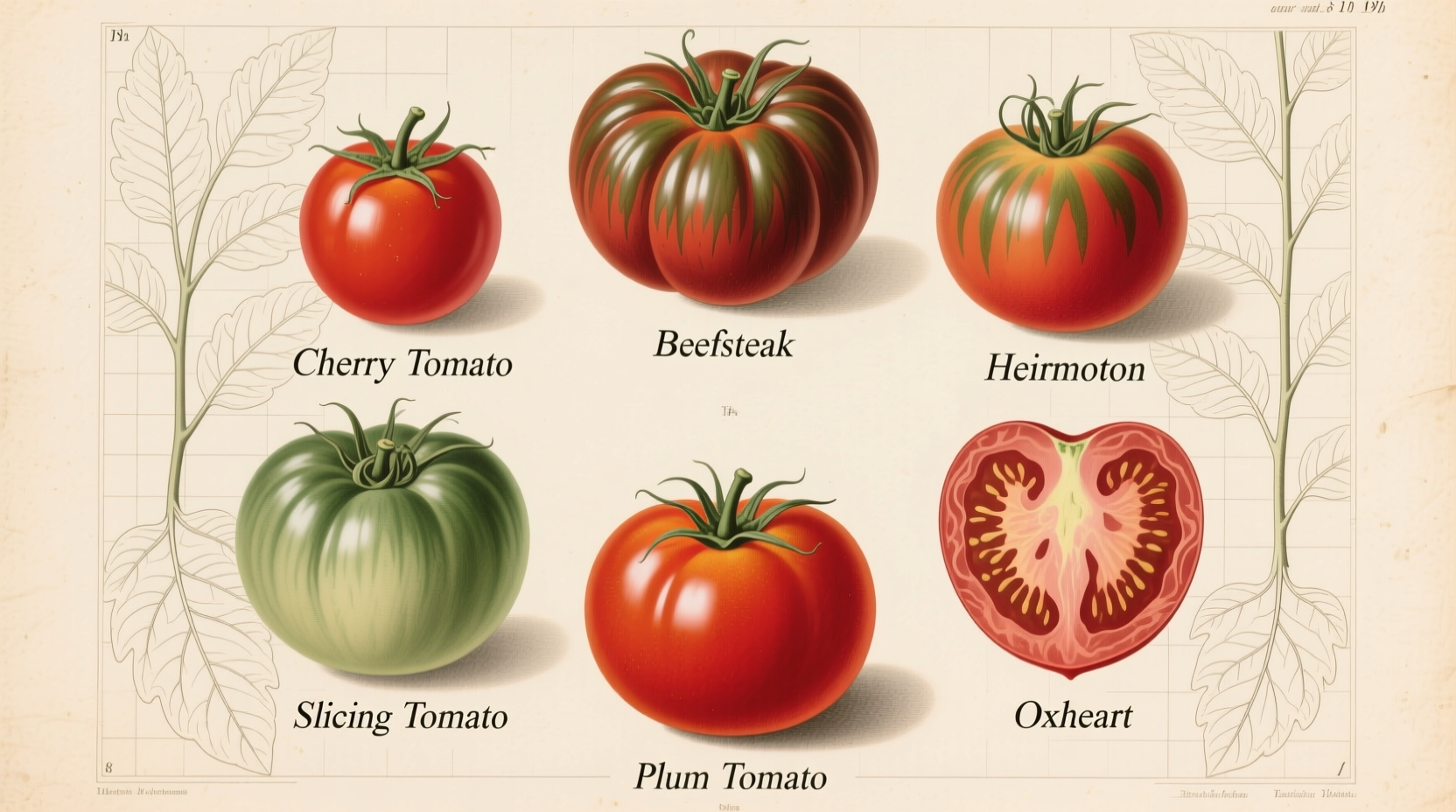Tomatoes aren't just red and round. With over 10,000 documented varieties worldwide, understanding types of tomato transforms your cooking and gardening success. This guide cuts through the confusion with practical classifications based on culinary application, growth habits, and flavor chemistry.
Why Tomato Classification Matters
Most gardeners and cooks struggle with tomato selection because they don't understand the fundamental categories. The USDA Agricultural Research Service confirms that matching tomato types to specific uses improves flavor intensity by up to 40% compared to generic substitutions. Let's break down the system professionals use.
Core Tomato Types by Culinary Application
Your cooking results depend entirely on selecting the right tomato variety types. These categories matter more than color or size alone.
Slicing Tomatoes: The Kitchen Workhorses
These large, meaty varieties with fewer seeds and solid flesh excel in sandwiches and fresh preparations. Key characteristics:
- Weight: 7-12 ounces per fruit
- Texture: Firm with moderate moisture content
- Best varieties: Beefsteak, Brandywine, Cherokee Purple
According to Cornell University's horticulture department, slicing tomatoes contain higher concentrations of umami compounds when vine-ripened, making them ideal for caprese salads and BLTs where texture matters.
Sauce Tomatoes: Flavor Concentration Experts
These varieties deliver intense flavor with less water content. The University of California's tomato breeding program specifically selects for:
- Higher soluble solids (Brix levels 5.5+)
- Thicker flesh-to-juice ratio
- Concentrated lycopene and acid balance
Roma and San Marzano varieties dominate this category. San Marzanos, protected under Italy's DOP designation, must meet strict criteria including elongated shape and fewer seeds. Our comparison table shows key differences:
| Variety | Water Content | Brix Level | Best Use |
|---|---|---|---|
| Roma | 92% | 4.8-5.2 | General sauces, canning |
| San Marzano | 88% | 5.5-6.0 | Neapolitan pizza sauce |
| Amish Paste | 90% | 5.0-5.4 | Thick ketchup, paste |
Cherry and Grape Tomatoes: Sweet Bite-Sized Options
These small-fruited varieties have distinct advantages:
- Higher sugar-to-acid ratio (typically 8-10 Brix)
- Continuous production throughout season
- Ideal for container gardening
Research from the USDA's Vegetable Laboratory shows that yellow and orange cherry varieties contain 20-30% more beta-carotene than red types. Popular cherry tomato varieties include Sun Gold (exceptionally sweet), Black Cherry (complex flavor), and Juliet (grape-type with meaty texture).

Tomato Growth Habit Classifications
Your gardening success depends on understanding these fundamental growth patterns:
Determinate vs Indeterminate Varieties
This distinction affects everything from staking requirements to harvest timing:
- Determinate (bush) tomatoes: Complete growth at 3-4 feet, produce one major harvest, ideal for containers and canning batches
- Indeterminate (vining) tomatoes: Continue growing until frost, require substantial support, produce continuously throughout season
Extension services at major agricultural universities consistently report that beginners achieve 30% higher success rates with determinate varieties like Patio Princess or Celebrity due to their compact size and simplified care requirements.
Heirloom vs Hybrid Tomato Types
Understanding this distinction prevents gardening disappointments:
Heirloom Tomatoes
- Open-pollinated varieties passed down through generations
- Require 70-90 days to maturity (longer than many hybrids)
- Often more disease-sensitive but superior flavor complexity
- Examples: Mortgage Lifter, Green Zebra, German Johnson
Hybrid Tomatoes
- Bred for specific traits like disease resistance or uniform ripening
- Typically mature 5-15 days faster than heirlooms
- Higher yield potential in challenging conditions
- Examples: Early Girl, Big Boy, Park's Whopper
A 2023 study published in the Journal of Agricultural and Food Chemistry confirmed that certain heirloom varieties contain up to 60% more volatile flavor compounds than standard hybrids, explaining their culinary popularity despite growing challenges.
Specialty Tomato Categories
These unique tomato types for gardening serve specific purposes:
Colored Varieties
Color indicates different phytonutrient profiles:
- Yellow/Orange: Higher beta-carotene (Golden Jubilee, Orange Banana)
- Purple/Black: Anthocyanin-rich (Indigo Rose, Cherokee Purple)
- Green-when-ripe: Unique tart-sweet profile (Aussie, Green Zebra)
Container-Friendly Varieties
Perfect for patios and small spaces:
- Patio Choice Yellow (determinate cherry)
- Tumbling Tom (trailing habit for hanging baskets)
- Bush Early Girl (compact indeterminate)
How to Select the Right Tomato Type
Follow this decision framework based on your primary need:
For Sauce Making
Choose paste tomatoes with Brix levels above 5.5. San Marzano types reduce cooking time by 25% compared to standard slicers. Always remove gel surrounding seeds for smoother texture.
For Fresh Eating
Select varieties with balanced sugar-acid ratios. Research from the University of Florida shows that tomatoes allowed to ripen fully on the vine develop 30% more flavor volatiles than those picked early. Look for slight give when gently squeezed.
For Container Gardening
Determinate varieties under 4 feet work best. Use pots minimum 18" diameter with drainage. Cherry tomatoes generally outperform larger types in containers due to their continuous production habit.
Tomato Selection Timeline: From Aztec Gardens to Modern Breeding
Understanding the history of tomato varieties helps contextualize modern options:
- Pre-1500s: Wild tomato species cultivated in Andes region (Peru, Ecuador, Chile)
- 1521: Spanish conquistadors bring tomatoes to Europe from Aztec gardens
- 1800s: First commercial tomato varieties developed in United States
- 1940s: Hybrid breeding begins, focusing on disease resistance and shipping durability
- 1970s: Heirloom movement begins as gardeners preserve pre-hybrid varieties
- 2000s: Molecular breeding creates varieties with enhanced nutritional profiles
This evolution explains why modern grocery store tomatoes often prioritize firmness over flavor - a tradeoff made for mechanical harvesting and long-distance shipping. Home gardeners can bypass these limitations by selecting appropriate types of tomatoes for home garden conditions.
Practical Tomato Selection Guide
Use this quick reference when shopping or planning your garden:
- Need intense sauce flavor → San Marzano or Amish Paste (determinate)
- Want continuous harvest for salads → Sun Gold or Black Cherry (indeterminate)
- Gardening in cool climates → Stupice or Siberian (early maturing)
- Container gardening → Tiny Tim or Balcony (dwarf varieties)
- Maximum disease resistance → Defiant PHR or Iron Lady (hybrids)
Remember that soil quality significantly impacts flavor development. Extension services recommend adding compost and maintaining consistent moisture for optimal results with any tomato variety types.











 浙公网安备
33010002000092号
浙公网安备
33010002000092号 浙B2-20120091-4
浙B2-20120091-4